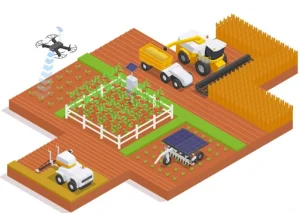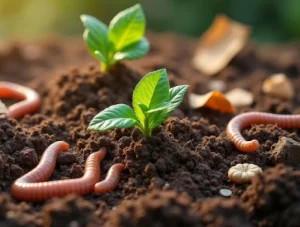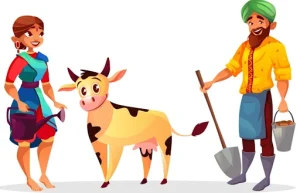A Seed Tells a Farmer’s Story – Inspiring Lessons from Indian Farming for Class 5
Welcome to iPrep – Your Learning Super App
A Seed Tells a Farmer’s Story explores farm life, traditions, and modern changes, teaching children important values and the impact of farming from seed to plate. Through this chapter, children explore how farming has changed over time and what it means to grow food in a sustainable and respectful way. Whether you’re studying for an upcoming exam or strengthening your concepts, our engaging animated videos, practice questions and notes offer you the best of integrated learning with interesting explanations and examples.
A Seed Tells a Farmer’s Story
A Seed Tells a Farmer’s Story is your doorway into the world of farming. From the moment a tiny seed is planted in the soil, to the family meals that celebrate the harvest, this story brings alive the hope, skill, and lessons that each farmer plants in the land. On iPrep, your learning super app, discover how A Seed Tells a Farmer’s Story unfolds across time, revealing the rich history, hard work, and new ideas that shape every grain of food.

Undhiya, a delicious Gujarati dish made during winters.
Explore how A Seed Tells a Farmer’s Story captures the life, labor, and lessons behind every harvest from soil to seedling and beyond. Through this chapter, children see how farming has changed over time and why growing food in a sustainable and respectful way still matters today.
Life in Vangaam – Simpler Times, Rich Traditions
In Vangaam’s early days, farming was closely connected to nature. Local farmers grew crops like bajra, jowar, and vegetables. They preserved seeds in dried gourds or boxes with neem leaves. At harvest, families enjoyed special meals:- undhiya, bajra rotis—made from the grains they had grown and stored with care.
Activity:
- Ask an elder in your family about undhiya or bajra roti. Try cooking it with them and note your experience.
- Collect stories about farming or seeds from your community. Write a short journal entry titled “A Seed Tells a Farmer’s Story.”
A Seed Tells a Farmer’s Story: From Soil to Sky
With careful planning, farmers select each seed, thinking of the changing seasons and the needs of their land. In this moment, A Seed Tells a Farmer’s Story takes root. Preparing the ground is preparing the next chapter, softening, nourishing, waiting for the first green shoot.
Every day, the farmer trusts the journey, never sure how storms or sunshine will shape the crop. But every farmer knows that planting seeds also plants hope for the future.
As the years passed in Vangaam:
- Irrigation canals and pumps made it easier to grow more crops.
- Farmers began planting wheat and cotton to sell in the markets.
- Yet, traditional seeds and ancient wisdom faded as new methods appeared. A Seed Tells a Farmer’s Story reminds us why preserving local knowledge and old varieties matters.

Modern farming practices with machines.
What A Seed Tells a Farmer’s Story Reveals About Farming Today
Nurturing Roots – A Seed Tells a Farmer’s Story of Persistence
Below the soil, unseen roots spread and grow strong, searching for water and food. Above ground, sprouts push upward, eager for sunlight. This part of A Seed Tells a Farmer’s Story is about patience, care, and adapting to surprises, like storms or pests.
Sometimes, old ways are changed by new machines.
From Bullocks to Tractors – Mechanisation of Farming
- Tractors replaced bullocks.
- Electric pumps supplied water.
- Market crops brought new profits.
But there were downsides, too: fewer jobs for labourers, lost traditions, and animals no longer needed.
A Seed Tells a Farmer’s Story: Modern Farming and Its Hidden Costs
Modern farming introduced fertilizers, pesticides, and water-hungry seeds. Farmers took loans for high-tech seeds, but if too many people grew the same crop, prices dropped. Some left farming behind.
Discussion Questions:
- Do modern changes in farming benefit everyone equally?
- Which crops grow in your area, are they new or traditional?
Bhaskarbhai’s Organic Farm – A Return to Nature
A Seed Tells a Farmer’s Story also teaches us about working with nature. Bhaskarbhai’s Gujarat farm uses:
- Croton plants to check soil dryness
- Earthworms to enrich soil
- Composting with vegetable waste

Earthworms improve soil health by making tunnels and adding nutrients.
Activity:
-
Make compost at home. Use vegetable peels, dry leaves, and soil. Watch what changes week by week.
A Seed Tells a Farmer’s Story: From Seed to Plate
Follow the journey:
- Bajra cobs are crushed to extract seeds.
- Seeds are ground for flour.
- Flour becomes dough, and dough turns into bajra rotis.
Machines help, but traditional ways protect culture and the environment.
A Seed Tells a Farmer’s Story: Harvest and Heritage
Golden fields signal it’s time to gather the crops. Each full basket adds to A Seed Tells a Farmer’s Story. Harvest is both a reward and a reminder to pass on what we know.
Activities:
- Create a photo story of harvest traditions in your area.
- Write a poem about harvest season.
- Host a storytelling event: “A Seed Tells a Farmer’s Story.”
What A Seed Tells a Farmer’s Story Teaches Us
This CBSE lesson shares important truths:
- Traditional farming is gentle to the earth.
- New techniques can improve crops but must be used wisely.
- Balancing both ensures enough food and a healthy planet.
A Seed Tells a Farmer’s Story shows that every meal comes from hard work and hope. Let’s honor our farmers one seed, one field, one season at a time.
Final Activity:
Interview a Farmer:

Visit a local farm or talk to a farmer. Ask about the crops, water needs, tools, and challenges. Write a short report about what you learned and share it with your class!
Chapter Summary
A Seed Tells a Farmer’s Story is more than a farming lesson:- it’s a journey through choices, culture, and careful progress. By learning where our food comes from, we connect with our land and our history.
To read the NCERT text of A Seed Tells a Farmer’s Story, click here.
To read our notes for the previous chapter, No Place for Us?, click here.
Practice questions on A Seed Tells a Farmer’s Story
Get your free A Seed Tells a Farmer’s Story practice quiz of 20+ questions & detailed solutions
Practice Now








